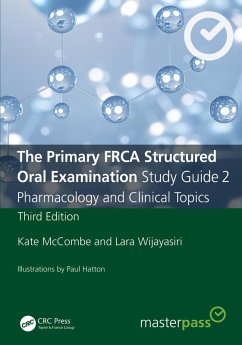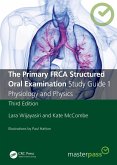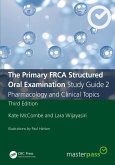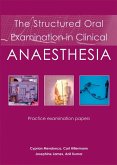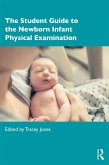Kate Mccombe, Lara Wijayasiri
The Primary FRCA Structured Oral Examination Study Guide 2 (eBook, PDF)
Pharmacology and Clinical Topics
54,95 €
54,95 €
inkl. MwSt.
Erscheint vor. 25.03.25

27 °P sammeln
54,95 €
Als Download kaufen

54,95 €
inkl. MwSt.
Erscheint vor. 25.03.25

27 °P sammeln
Jetzt verschenken
Alle Infos zum eBook verschenken
54,95 €
inkl. MwSt.
Erscheint vor. 25.03.25
Alle Infos zum eBook verschenken

27 °P sammeln
Unser Service für Vorbesteller - Ihr Vorteil ohne Risiko:
Sollten wir den Preis dieses Artikels vor dem Erscheinungsdatum senken, werden wir Ihnen den Artikel bei der Auslieferung automatisch zum günstigeren Preis berechnen.
Sollten wir den Preis dieses Artikels vor dem Erscheinungsdatum senken, werden wir Ihnen den Artikel bei der Auslieferung automatisch zum günstigeren Preis berechnen.
Kate Mccombe, Lara Wijayasiri
The Primary FRCA Structured Oral Examination Study Guide 2 (eBook, PDF)
Pharmacology and Clinical Topics
- Format: PDF
- Merkliste
- Auf die Merkliste
- Bewerten Bewerten
- Teilen
- Produkt teilen
- Produkterinnerung
- Produkterinnerung

Bitte loggen Sie sich zunächst in Ihr Kundenkonto ein oder registrieren Sie sich bei
bücher.de, um das eBook-Abo tolino select nutzen zu können.
Hier können Sie sich einloggen
Hier können Sie sich einloggen
Sie sind bereits eingeloggt. Klicken Sie auf 2. tolino select Abo, um fortzufahren.

Bitte loggen Sie sich zunächst in Ihr Kundenkonto ein oder registrieren Sie sich bei bücher.de, um das eBook-Abo tolino select nutzen zu können.
The Primary FRCA Structured Oral Examination Study Guide 2: Pharmacology and Clinical Topics 3e provides answers to the questions regularly posed by the FRCA examiners, with key information to succeed in the Primary FRCA examination collated and delivered in a relevant and user-friendly layout, making exam preparation easier.
- Geräte: PC
- mit Kopierschutz
- eBook Hilfe
Andere Kunden interessierten sich auch für
![The Primary FRCA Structured Oral Examination Study Guide 1 (eBook, PDF) The Primary FRCA Structured Oral Examination Study Guide 1 (eBook, PDF)]() Lara WijayasiriThe Primary FRCA Structured Oral Examination Study Guide 1 (eBook, PDF)55,95 €
Lara WijayasiriThe Primary FRCA Structured Oral Examination Study Guide 1 (eBook, PDF)55,95 €![The Primary FRCA Structured Oral Examination Study Guide 2 (eBook, ePUB) The Primary FRCA Structured Oral Examination Study Guide 2 (eBook, ePUB)]() Kate MccombeThe Primary FRCA Structured Oral Examination Study Guide 2 (eBook, ePUB)55,95 €
Kate MccombeThe Primary FRCA Structured Oral Examination Study Guide 2 (eBook, ePUB)55,95 €![The Primary FRCA Structured Oral Examination Study Guide 1 (eBook, ePUB) The Primary FRCA Structured Oral Examination Study Guide 1 (eBook, ePUB)]() Lara WijayasiriThe Primary FRCA Structured Oral Examination Study Guide 1 (eBook, ePUB)55,95 €
Lara WijayasiriThe Primary FRCA Structured Oral Examination Study Guide 1 (eBook, ePUB)55,95 €![Handbook of Clinical Anaesthesia, Fourth edition (eBook, PDF) Handbook of Clinical Anaesthesia, Fourth edition (eBook, PDF)]() Handbook of Clinical Anaesthesia, Fourth edition (eBook, PDF)88,95 €
Handbook of Clinical Anaesthesia, Fourth edition (eBook, PDF)88,95 €![Structured Oral Examination in Clinical Anaesthesia (eBook, PDF) Structured Oral Examination in Clinical Anaesthesia (eBook, PDF)]() Cyprian MendoncaStructured Oral Examination in Clinical Anaesthesia (eBook, PDF)53,99 €
Cyprian MendoncaStructured Oral Examination in Clinical Anaesthesia (eBook, PDF)53,99 €![The Student Guide to the Newborn Infant Physical Examination (eBook, PDF) The Student Guide to the Newborn Infant Physical Examination (eBook, PDF)]() The Student Guide to the Newborn Infant Physical Examination (eBook, PDF)31,95 €
The Student Guide to the Newborn Infant Physical Examination (eBook, PDF)31,95 €![Oral and Oropharyngeal Cancer (eBook, PDF) Oral and Oropharyngeal Cancer (eBook, PDF)]() Oral and Oropharyngeal Cancer (eBook, PDF)220,95 €
Oral and Oropharyngeal Cancer (eBook, PDF)220,95 €-
-
-
The Primary FRCA Structured Oral Examination Study Guide 2: Pharmacology and Clinical Topics 3e provides answers to the questions regularly posed by the FRCA examiners, with key information to succeed in the Primary FRCA examination collated and delivered in a relevant and user-friendly layout, making exam preparation easier.
Dieser Download kann aus rechtlichen Gründen nur mit Rechnungsadresse in A, B, BG, CY, CZ, D, DK, EW, E, FIN, F, GR, HR, H, IRL, I, LT, L, LR, M, NL, PL, P, R, S, SLO, SK ausgeliefert werden.
Produktdetails
- Produktdetails
- Verlag: Taylor & Francis eBooks
- Seitenzahl: 332
- Erscheinungstermin: 25. März 2025
- Englisch
- ISBN-13: 9781040309292
- Artikelnr.: 73154346
- Verlag: Taylor & Francis eBooks
- Seitenzahl: 332
- Erscheinungstermin: 25. März 2025
- Englisch
- ISBN-13: 9781040309292
- Artikelnr.: 73154346
- Herstellerkennzeichnung Die Herstellerinformationen sind derzeit nicht verfügbar.
Kate McCombe, Consultant Anaesthetist, Frimley Health NHS Trust, Surrey, UK
Lara Wijayasiri, Consultant Anaesthetist, Ashford and St Peter's Hospitals NHS Trust, Surrey, UK
Lara Wijayasiri, Consultant Anaesthetist, Ashford and St Peter's Hospitals NHS Trust, Surrey, UK
Part 1 - Pharmacology
1 Receptors
2 Mechanism of Drug Action
3 Drug Interactions
4 Drug Absorption and Bioavailability
5 Drugs and the Liver
6 Drugs and the Kidney
7 Variations in Drug Metabolism
8 Isomers
9 Drugs to Draw
10 Exponential Functions
11 Dose-Response Curves
12 First- and Zero-Order Kinetics
13 Volume of Distribution, Clearance and Half-Life
14 Compartment Models
15 Total Intravenous Anaesthesia
16 Induction Agents
17 Nitrous Oxide
18 Inhalational Anaesthetic Agents (Volatile Agents)
19 Neuromuscular Blocking Drugs
20 Cholinesterase Inhibitors (Anticholinesterases) And Reversal Agents
21 Antimuscarinic Drugs
22 Opioids
23 Sedative Agents
24 Local Anaesthetics
25 Antiemetics and Prokinetics
26 Antiarrhythmic Drugs
27 Antihypertensive Agents
28 Diuretics
29 Non-Steroidal Anti-Inflammatory Drugs
30 Antimicrobials
31 Anticoagulants
32 Anti-Platelet Agents
33 Blood
34 Hypoglycaemic Agents
35 Anticonvulsants
36 Antidepressants
37 Drugs used to Treat Asthma
38 Miscellaneous Drugs
Part 2 - Special patient groups
39 The Jehovah's Witness
40 Obesity
41 Paediatric Patient
42 Pregnancy
43 Pre-Eclampsia Toxaemia
44 Elderly Patient
45 Down's Syndrome
46 Sickle Cell Anaemia
47 Rheumatoid Arthritis
48 Diabetes
49 Hypertensive Patient
50 Chronic Obstructive Pulmonary Disease
51 Burns and Trauma
52 Brainstem Death and Organ Donation
Part 3 - Critical incidents
53 Anaphylaxis
54 Aspiration
55 Awareness
56 Blood Transfusion Error
57 Bradycardia
58 Cyanosis
59 Difficult to Ventilate (High Airway Pressures)
60 Failed Intubation
61 Failure to Breathe
62 High Spinal Block
63 Hypertension
64 Hypotension
65 Hypoxia
66 Intra-Arterial Injection
67 Laryngospasm
68 Local Anaesthetic Toxicity
69 Major Obstetric Haemorrhage
70 Malignant Hyperpyrexia
71 Needlestick Injury
72 Post-Dural Puncture Headache
73 ST Segment Changes
74 Tachyarrhythmias
75 Venous Air Embolism (VAE)
1 Receptors
2 Mechanism of Drug Action
3 Drug Interactions
4 Drug Absorption and Bioavailability
5 Drugs and the Liver
6 Drugs and the Kidney
7 Variations in Drug Metabolism
8 Isomers
9 Drugs to Draw
10 Exponential Functions
11 Dose-Response Curves
12 First- and Zero-Order Kinetics
13 Volume of Distribution, Clearance and Half-Life
14 Compartment Models
15 Total Intravenous Anaesthesia
16 Induction Agents
17 Nitrous Oxide
18 Inhalational Anaesthetic Agents (Volatile Agents)
19 Neuromuscular Blocking Drugs
20 Cholinesterase Inhibitors (Anticholinesterases) And Reversal Agents
21 Antimuscarinic Drugs
22 Opioids
23 Sedative Agents
24 Local Anaesthetics
25 Antiemetics and Prokinetics
26 Antiarrhythmic Drugs
27 Antihypertensive Agents
28 Diuretics
29 Non-Steroidal Anti-Inflammatory Drugs
30 Antimicrobials
31 Anticoagulants
32 Anti-Platelet Agents
33 Blood
34 Hypoglycaemic Agents
35 Anticonvulsants
36 Antidepressants
37 Drugs used to Treat Asthma
38 Miscellaneous Drugs
Part 2 - Special patient groups
39 The Jehovah's Witness
40 Obesity
41 Paediatric Patient
42 Pregnancy
43 Pre-Eclampsia Toxaemia
44 Elderly Patient
45 Down's Syndrome
46 Sickle Cell Anaemia
47 Rheumatoid Arthritis
48 Diabetes
49 Hypertensive Patient
50 Chronic Obstructive Pulmonary Disease
51 Burns and Trauma
52 Brainstem Death and Organ Donation
Part 3 - Critical incidents
53 Anaphylaxis
54 Aspiration
55 Awareness
56 Blood Transfusion Error
57 Bradycardia
58 Cyanosis
59 Difficult to Ventilate (High Airway Pressures)
60 Failed Intubation
61 Failure to Breathe
62 High Spinal Block
63 Hypertension
64 Hypotension
65 Hypoxia
66 Intra-Arterial Injection
67 Laryngospasm
68 Local Anaesthetic Toxicity
69 Major Obstetric Haemorrhage
70 Malignant Hyperpyrexia
71 Needlestick Injury
72 Post-Dural Puncture Headache
73 ST Segment Changes
74 Tachyarrhythmias
75 Venous Air Embolism (VAE)
Part 1 - Pharmacology
1 Receptors
2 Mechanism of Drug Action
3 Drug Interactions
4 Drug Absorption and Bioavailability
5 Drugs and the Liver
6 Drugs and the Kidney
7 Variations in Drug Metabolism
8 Isomers
9 Drugs to Draw
10 Exponential Functions
11 Dose-Response Curves
12 First- and Zero-Order Kinetics
13 Volume of Distribution, Clearance and Half-Life
14 Compartment Models
15 Total Intravenous Anaesthesia
16 Induction Agents
17 Nitrous Oxide
18 Inhalational Anaesthetic Agents (Volatile Agents)
19 Neuromuscular Blocking Drugs
20 Cholinesterase Inhibitors (Anticholinesterases) And Reversal Agents
21 Antimuscarinic Drugs
22 Opioids
23 Sedative Agents
24 Local Anaesthetics
25 Antiemetics and Prokinetics
26 Antiarrhythmic Drugs
27 Antihypertensive Agents
28 Diuretics
29 Non-Steroidal Anti-Inflammatory Drugs
30 Antimicrobials
31 Anticoagulants
32 Anti-Platelet Agents
33 Blood
34 Hypoglycaemic Agents
35 Anticonvulsants
36 Antidepressants
37 Drugs used to Treat Asthma
38 Miscellaneous Drugs
Part 2 - Special patient groups
39 The Jehovah's Witness
40 Obesity
41 Paediatric Patient
42 Pregnancy
43 Pre-Eclampsia Toxaemia
44 Elderly Patient
45 Down's Syndrome
46 Sickle Cell Anaemia
47 Rheumatoid Arthritis
48 Diabetes
49 Hypertensive Patient
50 Chronic Obstructive Pulmonary Disease
51 Burns and Trauma
52 Brainstem Death and Organ Donation
Part 3 - Critical incidents
53 Anaphylaxis
54 Aspiration
55 Awareness
56 Blood Transfusion Error
57 Bradycardia
58 Cyanosis
59 Difficult to Ventilate (High Airway Pressures)
60 Failed Intubation
61 Failure to Breathe
62 High Spinal Block
63 Hypertension
64 Hypotension
65 Hypoxia
66 Intra-Arterial Injection
67 Laryngospasm
68 Local Anaesthetic Toxicity
69 Major Obstetric Haemorrhage
70 Malignant Hyperpyrexia
71 Needlestick Injury
72 Post-Dural Puncture Headache
73 ST Segment Changes
74 Tachyarrhythmias
75 Venous Air Embolism (VAE)
1 Receptors
2 Mechanism of Drug Action
3 Drug Interactions
4 Drug Absorption and Bioavailability
5 Drugs and the Liver
6 Drugs and the Kidney
7 Variations in Drug Metabolism
8 Isomers
9 Drugs to Draw
10 Exponential Functions
11 Dose-Response Curves
12 First- and Zero-Order Kinetics
13 Volume of Distribution, Clearance and Half-Life
14 Compartment Models
15 Total Intravenous Anaesthesia
16 Induction Agents
17 Nitrous Oxide
18 Inhalational Anaesthetic Agents (Volatile Agents)
19 Neuromuscular Blocking Drugs
20 Cholinesterase Inhibitors (Anticholinesterases) And Reversal Agents
21 Antimuscarinic Drugs
22 Opioids
23 Sedative Agents
24 Local Anaesthetics
25 Antiemetics and Prokinetics
26 Antiarrhythmic Drugs
27 Antihypertensive Agents
28 Diuretics
29 Non-Steroidal Anti-Inflammatory Drugs
30 Antimicrobials
31 Anticoagulants
32 Anti-Platelet Agents
33 Blood
34 Hypoglycaemic Agents
35 Anticonvulsants
36 Antidepressants
37 Drugs used to Treat Asthma
38 Miscellaneous Drugs
Part 2 - Special patient groups
39 The Jehovah's Witness
40 Obesity
41 Paediatric Patient
42 Pregnancy
43 Pre-Eclampsia Toxaemia
44 Elderly Patient
45 Down's Syndrome
46 Sickle Cell Anaemia
47 Rheumatoid Arthritis
48 Diabetes
49 Hypertensive Patient
50 Chronic Obstructive Pulmonary Disease
51 Burns and Trauma
52 Brainstem Death and Organ Donation
Part 3 - Critical incidents
53 Anaphylaxis
54 Aspiration
55 Awareness
56 Blood Transfusion Error
57 Bradycardia
58 Cyanosis
59 Difficult to Ventilate (High Airway Pressures)
60 Failed Intubation
61 Failure to Breathe
62 High Spinal Block
63 Hypertension
64 Hypotension
65 Hypoxia
66 Intra-Arterial Injection
67 Laryngospasm
68 Local Anaesthetic Toxicity
69 Major Obstetric Haemorrhage
70 Malignant Hyperpyrexia
71 Needlestick Injury
72 Post-Dural Puncture Headache
73 ST Segment Changes
74 Tachyarrhythmias
75 Venous Air Embolism (VAE)
